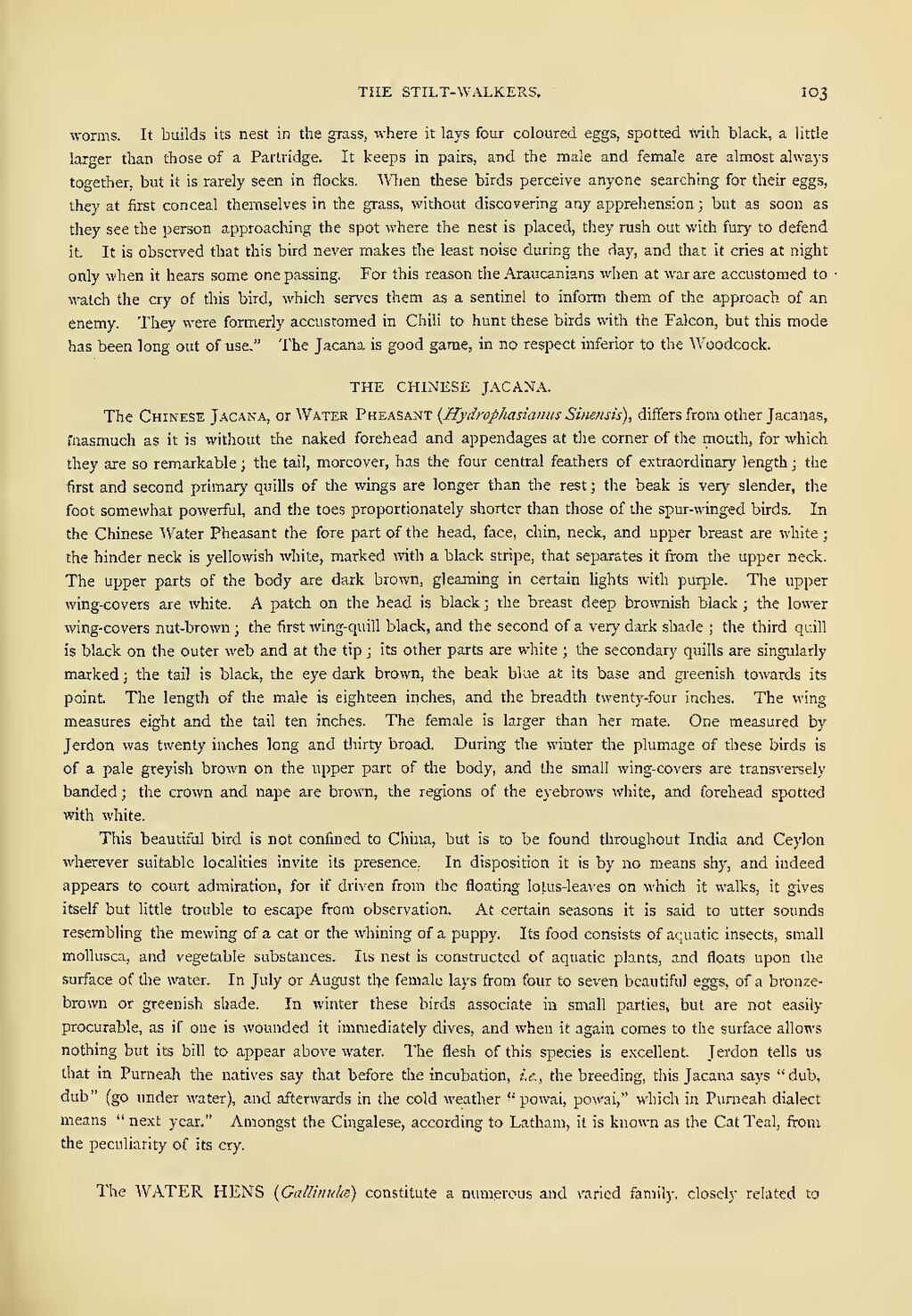worms. It builds its nest in the grass, where it lays four coloured eggs, spotted with black, a little larger than those of a Partridge. It keeps in pairs, and the male and female are almost always together, but it is rarely seen in flocks. When these birds perceive anyone searching for their eggs, they at first conceal themselves in the grass, without discovering any apprehension; but as soon as they see the person approaching the spot where the nest is placed, they rush out with fury to defend it. It is observed that this bird never makes the least noise during the day, and that it cries at night only when it hears some one passing. For this reason the Araucanians when at war are accustomed to watch the cry of this bird, which serves them as a sentinel to inform them of the approach of an enemy. They were formerly accustomed in Chili to hunt these birds with the Falcon, but this mode has been long out of use." The Jacana is good game, in no respect inferior to the Woodcock.
THE CHINESE JACANA.
The Chinese Jacana, or Water Pheasant (Hydrophasianus Sinensis), differs from other Jacanas, inasmuch as it is without the naked forehead and appendages at the corner of the mouth, for which they are so remarkable; the tail, moreover, has the four central feathers of extraordinary length; the first and second primary quills of the wings are longer than the rest; the beak is very slender, the foot somewhat powerful, and the toes proportionately shorter than those of the spur-winged birds. In the Chinese Water Pheasant the fore part of the head, face, chin, neck, and upper breast are white; the hinder neck is yellowish white, marked with a black stripe, that separates it from the upper neck. The upper parts of the body are dark brown, gleaming in certain lights with purple. The upper wing-covers are white. A patch on the head is black; the breast deep brownish black; the lower wing-covers nut-brown; the first wing-quill black, and the second of a very dark shade; the third quill is black on the outer web and at the tip; its other parts are white; the secondary quills are singularly marked; the tail is black, the eye dark brown, the beak blue at its base and greenish towards its point. The length of the male is eighteen inches, and the breadth twenty-four inches. The wing measures eight and the tail ten inches. The female is larger than her mate. One measured by Jerdon was twenty inches long and thirty broad. During the winter the plumage of these birds is of a pale greyish brown on the upper part of the body, and the small wing-covers are transversely banded; the crown and nape are brown, the regions of the eyebrows white, and forehead spotted with white.
This beautiful bird is not confined to China, but is to be found throughout India and Ceylon wherever suitable localities invite its presence. In disposition it is by no means shy, and indeed appears to court admiration, for if driven from the floating lotus-leaves on which it walks, it gives itself but little trouble to escape from observation. At certain seasons it is said to utter sounds resembling the mewing of a cat or the whining of a puppy. Its food consists of aquatic insects, small mollusca, and vegetable substances. Its nest is constructed of aquatic plants, and floats upon the surface of the water. In July or August the female lays from four to seven beautiful eggs, of a bronze-brown or greenish shade. In winter these birds associate in small parties, but are not easily procurable, as if one is wounded it immediately dives, and when it again comes to the surface allows nothing but its bill to appear above water. The flesh of this species is excellent. Jerdon tells us that in Purneah the natives say that before the incubation, i.e., the breeding, this Jacana says "dub, dub" (go under water), and afterwards in the cold weather "powai, powai," which in Purneah dialect means "next year." Amongst the Cingalese, according to Latham, it is known as the Cat Teal, from the peculiarity of its cry.
The WATER HENS (Gallinulæ) constitute a numerous and varied family, closely related to
